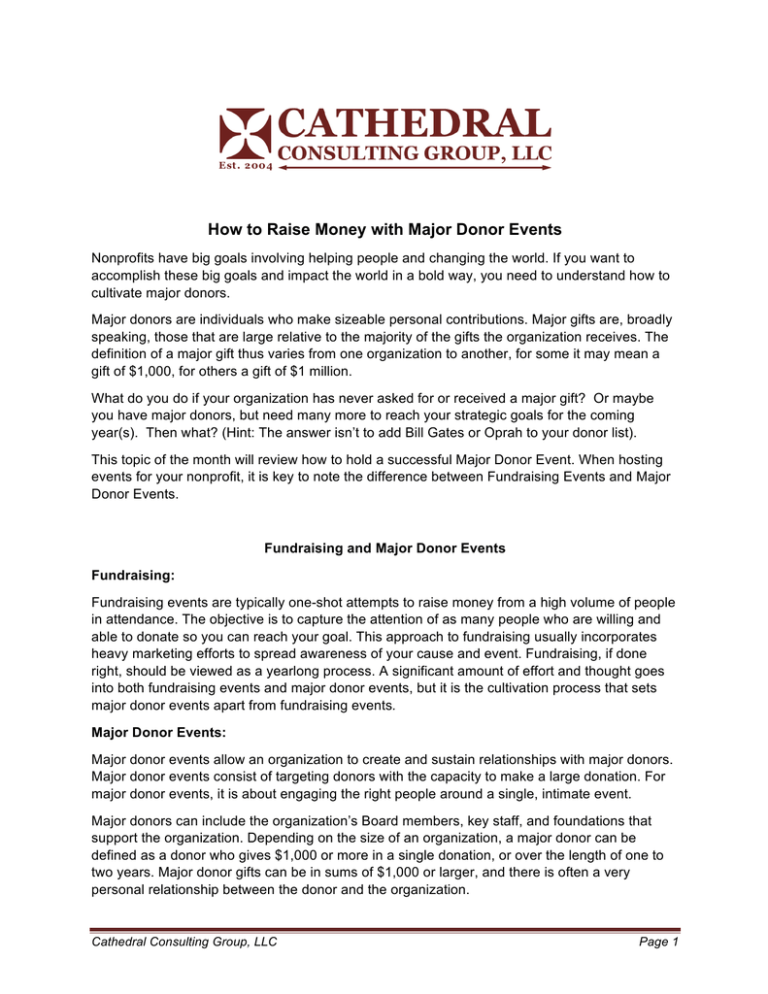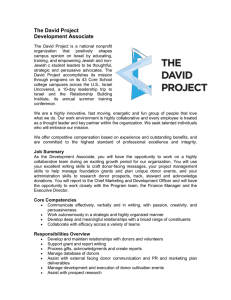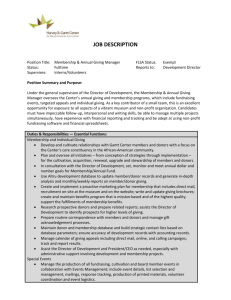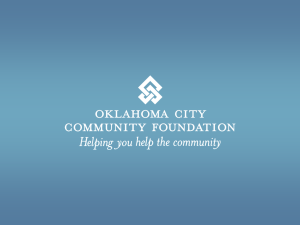How to Raise Money with Major Donor Events
advertisement

How to Raise Money with Major Donor Events Nonprofits have big goals involving helping people and changing the world. If you want to accomplish these big goals and impact the world in a bold way, you need to understand how to cultivate major donors. Major donors are individuals who make sizeable personal contributions. Major gifts are, broadly speaking, those that are large relative to the majority of the gifts the organization receives. The definition of a major gift thus varies from one organization to another, for some it may mean a gift of $1,000, for others a gift of $1 million. What do you do if your organization has never asked for or received a major gift? Or maybe you have major donors, but need many more to reach your strategic goals for the coming year(s). Then what? (Hint: The answer isn’t to add Bill Gates or Oprah to your donor list). This topic of the month will review how to hold a successful Major Donor Event. When hosting events for your nonprofit, it is key to note the difference between Fundraising Events and Major Donor Events. Fundraising and Major Donor Events Fundraising: Fundraising events are typically one-shot attempts to raise money from a high volume of people in attendance. The objective is to capture the attention of as many people who are willing and able to donate so you can reach your goal. This approach to fundraising usually incorporates heavy marketing efforts to spread awareness of your cause and event. Fundraising, if done right, should be viewed as a yearlong process. A significant amount of effort and thought goes into both fundraising events and major donor events, but it is the cultivation process that sets major donor events apart from fundraising events. Major Donor Events: Major donor events allow an organization to create and sustain relationships with major donors. Major donor events consist of targeting donors with the capacity to make a large donation. For major donor events, it is about engaging the right people around a single, intimate event. Major donors can include the organization’s Board members, key staff, and foundations that support the organization. Depending on the size of an organization, a major donor can be defined as a donor who gives $1,000 or more in a single donation, or over the length of one to two years. Major donor gifts can be in sums of $1,000 or larger, and there is often a very personal relationship between the donor and the organization. Cathedral Consulting Group, LLC Page 1 An event that brings all major donors together in an intimate setting hosted at a home or respected venue communicates how the organization values the donors’ support. Keeping the setting intimate is essential to creating a high quality, exclusive environment. In some cases money will not be raised at a major donor event, and most of the people invited will not be able to attend. Although higher attendance is preferred, the invitation itself provides the organization with an opportunity to follow up with donors on a personal level, separate from the event. The benefits of a good turnout far outweigh the detriment of an effortless attempt, or not hosting an event at all. Major Donor Events Strategy The cultivation process is vital when engaging with major donors of nonprofits. It can be challenging to cultivate strong relationships with major donors. It is a multi-step process, where the event itself is considered to be one step in the process. The cultivation process for these donors includes various additional steps to ensure that donor supports the organization by way of an annual gift: The Purpose: The purpose of a major donor event is different from other fundraising and individual events. An individual event is typically an impersonal event where the goal is to get as many people to the event, entertain within the means of the organizations resources (theatrical, concerts, etc.), and raise as much money as possible. The purpose of major donor events is to the contrary; the focus is on the intimate setting. There is generally a special message at the event tailored to major donors. When thinking about the message, it is necessary to consider the audience, because a wrong step could create irreparable damage to the organization’s image. An example of this is a video published September 17th, 2012, when Mitt Romney, a presidential candidate at that point, was filmed at a private dinner of wealthy donors stating, “47% are dependent (on the government) and feel entitled.” This speech went viral and had a major negative impact on Romney’s campaign. Lastly, there should be some exclusivity in choice of venue, which demonstrates to major donors their value to the organization. Typically, a private home, golf course, or a private club delivers the organization’s impression of the major donor’s value. The Invitation: Quality, not quantity, should be the mantra when planning major donor events. The invitation should occur by way of a personal touch. A personal touch is when a donor is invited personally (whether by a phone call, email or in person). This personal touch further reinforces the exclusive nature of the event. Major donor fundraising occurs through relationships, where a personal touch is key. It is key that a process be implemented to ensure consistent follow-up. If a major donor cannot attend the event, in the same conversation, follow-up by trying to coordinate a face-to-face meeting. When considering a personal meeting time, show that the major donor’s schedule is a priority to improve the likelihood of closing a meeting time. Cathedral Consulting Group, LLC Page 2 Since not every person will be able to attend, a short list of “table fillers” (people who can fill the room and bring some atmosphere) should be generated. They should be people who reflect the mission, or who will add to the overall event experience for major donors. They should be people who can easily engage with the other attendees at the event. An example of table fillers would be local students engaged in the program. Lastly, when thinking about invitations, know who your champions are. Champions are individuals whom you know are dedicated to the organization’s cause, are considered reliable donors, and are the donors who contribute the most in funding. The success of an event, in terms of attendance and financial returns, can hinge on whether your champion is able to attend. It is recommended to take your champion’s schedule into account when setting the date and venue. It is generally understood that a champion can be asked to reach out to people he/she knows, whether they are other major donors or table fillers, and encourage them to attend. The Event: With the quality not quantity theme in mind, the invite list should be limited to a maximum of about 30 of the highest donors. The goal is to make sure that every major donor in attendance feels appreciated and valued. Keeping the invite list small allows for ample opportunities to personally interact with each major donor, delivering the message of importance that each major donors’ contribution is important to the organization’s cause. The Follow-up: The number one reason major donor events fail is because follow-up is either insufficient or did not occur. The follow-up phase in planning a major donor event is often when the most money is raised. The follow-up should be done by the person in the organization who has the best connection to the major donors. Assigning one on ones amongst the leaders in the organization will ensure that all donors are followed up with. Knowing and understanding what to say before it is said is crucial before connecting with major donors who’ve attended the event. That is why creating a script would be in the organizations best interest before contact is made. Cathedral Consulting Group, LLC Page 3 Time frame of Implementation: Six Weeks Prior Four Weeks Prior Three Weeks Prior • Set the Date and Loca5on. • Confirm date with host (if at someone's home) and with your champion donor ( If you have one). • Confirm mailing list. • Prepare invita5ons to be mailed. • Mail Invita5ons. • Begin to receive RSVPs. • Check with Board Members and key personnel to make sure they received the invita5on and that it is on their calendar. Two Weeks • Make personal touches (a phone call, email, or in person visit) to ensure invite was received. Prior One Week Prior Two to Three Days prior • Make follow-­‐ups to those you have not received an RSVP from. • AQendee list should be finalized. • Send reminder e-­‐mais and phone calls to confirm loca5on, direc5ons, or simply to provide a reminder that the event is on schedule and your expressed excitement for the donor's aQendance. As stated earlier the process is never easy, but the mission far outweighs the work required to be successful. We at Cathedral believe that if you apply the above mentioned steps for planning a successful major donor event, this would create a solid platform from which the Board and Executive Director can cultivate and expand their major donor network. Articles for Further Reading Below are articles that expand on the topic of cultivation and major donors. 1. Corporation of Public Broadcasting, Major Giving Initiative. “Launch Your Program: Cultivating Strategies.” http://majorgivingnow.org/launch/cultivation.html 2. The Fundraising Authority, “Beginner’s Guide to Donor Cultivation,” http://www.thefundraisingauthority.com/donor-cultivation/guide-to-donor-cultivation/ Peter Giersch is a Managing Director of Cathedral Consulting Group, LLC in our Milwaukee, WI office. Jessica Zignego is an Associate of Cathedral Consulting, LLC in our Milwaukee, WI office. Stephen L. Sumner is an Associate of Cathedral Consulting, LLC in our Basking Ridge, New Jersey office. For more information, please visit Cathedral Consulting Group, LLC online at www.cathedralconsulting.com or contact us at info@cathedralconsulting.com. Cathedral Consulting Group, LLC Page 4






